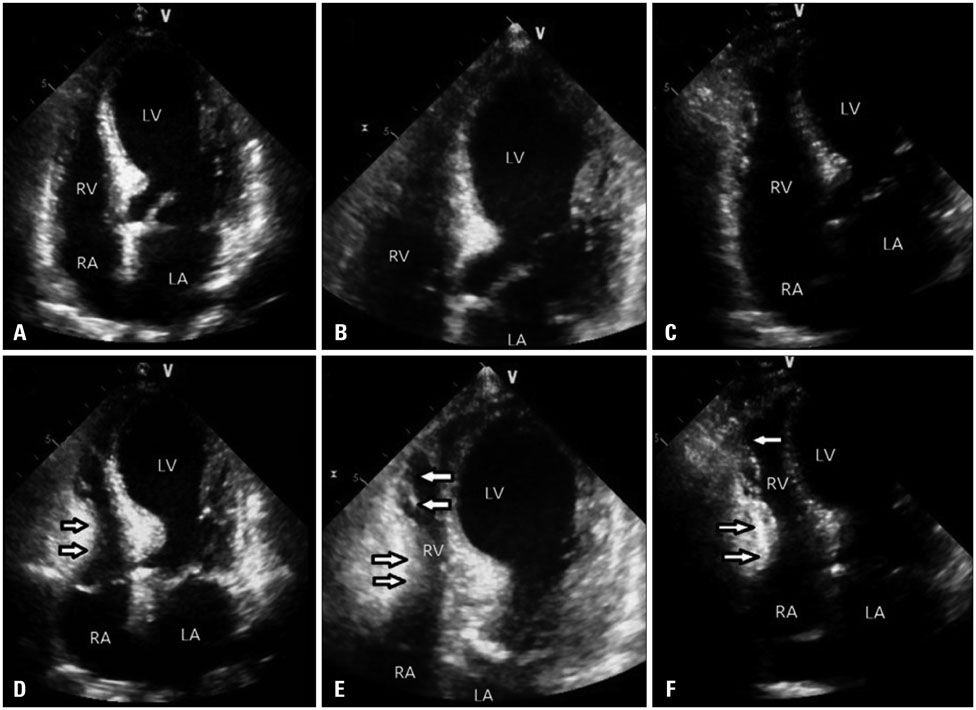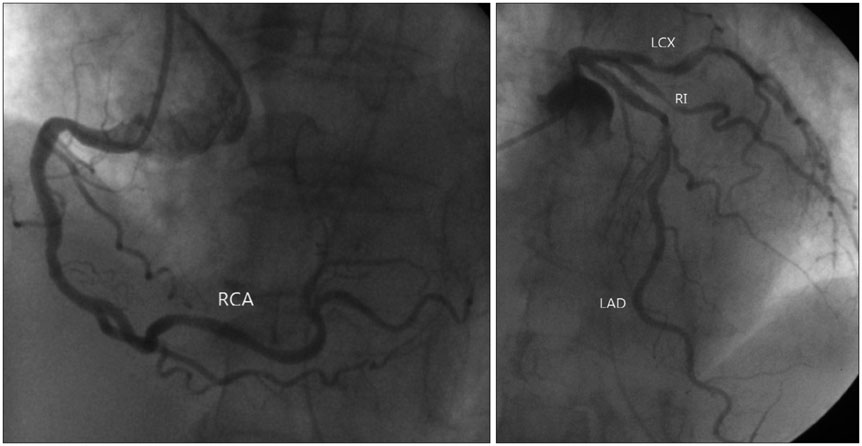J Cardiovasc Ultrasound.
2015 Dec;23(4):262-265. 10.4250/jcu.2015.23.4.262.
Biventricular Takotsubo Cardiomyopathy Associated with Epilepsy
- Affiliations
-
- 1Department of Internal Medicine, KEPCO Medical Center, Seoul, Korea.
- 2Division of Cardiology, KEPCO Medical Center, Seoul, Korea. gladyshong@gmail.com
- KMID: 2144458
- DOI: http://doi.org/10.4250/jcu.2015.23.4.262
Abstract
- We describe a case of Takotsubo cardiomyopathy in an elderly woman after status epilepticus. In an emergency echocardiography, not only left ventricular apical ballooning but also right ventricular apical hypokinesia was observed. After a medical management, the patient's condition was improved and a follow-up echocardiography showed substantial recovery of left and right ventricular apical ballooning.
Keyword
MeSH Terms
Figure
Reference
-
1. Ako J, Sudhir K, Farouque HM, Honda Y, Fitzgerald PJ. Transient left ventricular dysfunction under severe stress: brain-heart relationship revisited. Am J Med. 2006; 119:10–17.2. Ohtsuka T, Hamada M, Kodama K, Sasaki O, Suzuki M, Hara Y, Shigematsu Y, Hiwada K. Images in Cardiovascular Medicine. Neurogenic stunned myocardium. Circulation. 2000; 101:2122–2124.3. Stöllberger C, Huber JO, Enzelsberger B, Finsterer J. Fatal outcome of epileptic seizure-induced takotsubo syndrome with left ventricular rupture. Eur J Neurol. 2009; 16:e116–e117.4. Schneider F, Kadel C, Pagitz M, Sen S. Takotsubo cardiomyopathy and elevated troponin levels following cerebral seizure. Int J Cardiol. 2010; 145:586–587.5. Daoko J, Rajachandran M, Savarese R, Orme J. Biventricular takotsubo cardiomyopathy: case study and review of literature. Tex Heart Inst J. 2013; 40:305–311.6. Sato H, Tateishi H, Uchida T, Dote K, Ishihara M. Tako-tsubo-like left ventricular dysfunction due to multivessel coronary spasm. In : Kodama K, Haze K, Hori M, editors. Clinical aspect of myocardial injury: from ischemia to heart failure. Tokyo: Kagakuhyoronsya;1990. p. 56–64.7. Gianni M, Dentali F, Grandi AM, Sumner G, Hiralal R, Lonn E. Apical ballooning syndrome or takotsubo cardiomyopathy: a systematic review. Eur Heart J. 2006; 27:1523–1529.8. Yun MH, Choi S, Park JY, Kim CH, Beom JW, Park G, Kim SH. Coincident takotsubo cardiomyopathy and coronary artery disease. Korean J Med. 2012; 83:791–795.9. Yoshikawa T. Takotsubo cardiomyopathy, a new concept of cardiomyopathy: clinical features and pathophysiology. Int J Cardiol. 2015; 182:297–303.10. Meierkord H, Shorvon S, Lightman SL. Plasma concentrations of prolactin, noradrenaline, vasopressin and oxytocin during and after a prolonged epileptic seizure. Acta Neurol Scand. 1994; 90:73–77.11. Simon RP, Aminoff MJ, Benowitz NL. Changes in plasma catecholamines after tonic-clonic seizures. Neurology. 1984; 34:255–257.12. Shimizu M, Kagawa A, Takano T, Masai H, Miwa Y. Neurogenic stunned myocardium associated with status epileptics and postictal catecholamine surge. Intern Med. 2008; 47:269–273.13. Lee JW, Kim JY, Youn YJ, Sung JK, Lee NS, Lee KH, Yoo BS, Lee SH, Yoon J, Choe KH. Clinical characteristics and prognostic factors of stress-induced cardiomyopathy. Korean Circ J. 2010; 40:277–282.14. Le Ven F, Pennec PY, Timsit S, Blanc JJ. Takotsubo syndrome associated with seizures: an underestimated cause of sudden death in epilepsy? Int J Cardiol. 2011; 146:475–479.15. Haghi D, Athanasiadis A, Papavassiliu T, Suselbeck T, Fluechter S, Mahrholdt H, Borggrefe M, Sechtem U. Right ventricular involvement in Takotsubo cardiomyopathy. Eur Heart J. 2006; 27:2433–2439.
- Full Text Links
- Actions
-
Cited
- CITED
-
- Close
- Share
- Similar articles
-
- Response to Letter Regarding Article, "Biventricular Takotsubo Cardiomyopathy Associated with Epilepsy"
- Letter Regarding Article, "Biventricular Takotsubo Cardiomyopathy Associated with Epilepsy"
- A Case of Reversal of Takotsubo Cardiomyopathy in Patient with Pheochromocytoma
- Takotsubo Cardiomyopathy Associated With Status Epilepticus
- Rupture of Right Ventricular Free Wall Following Ventricular Septal Rupture in Takotsubo Cardiomyopathy with Right Ventricular Involvement






